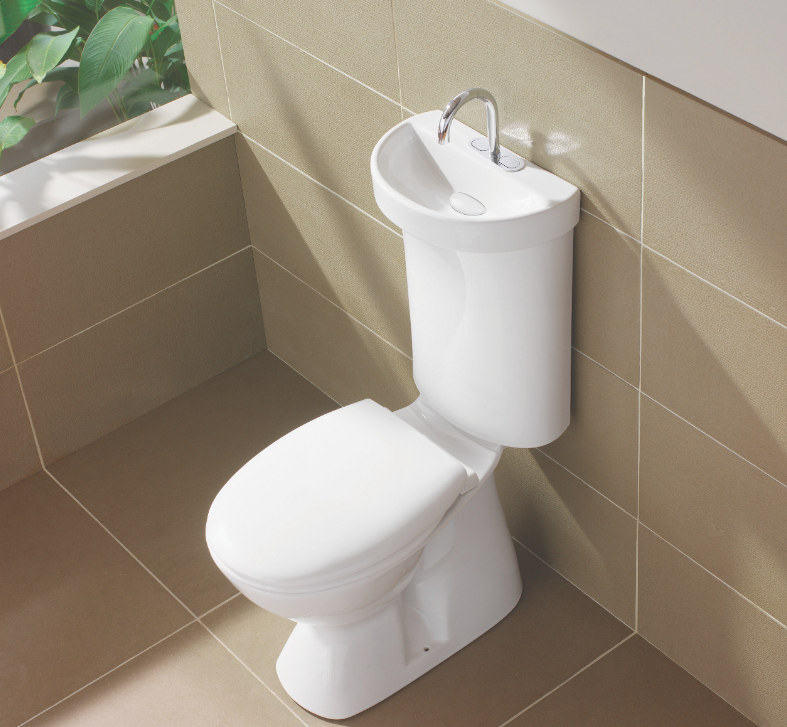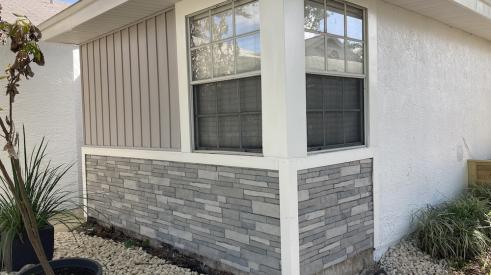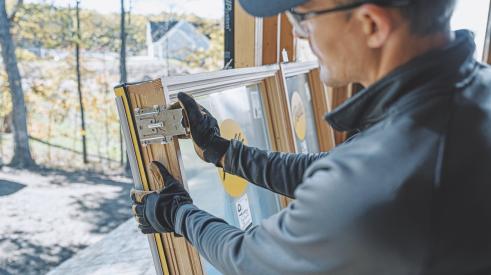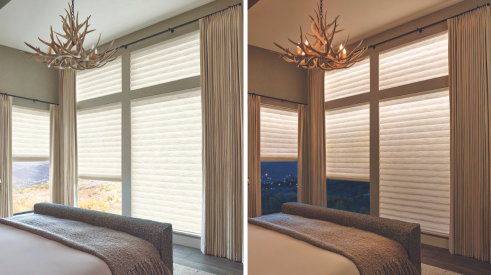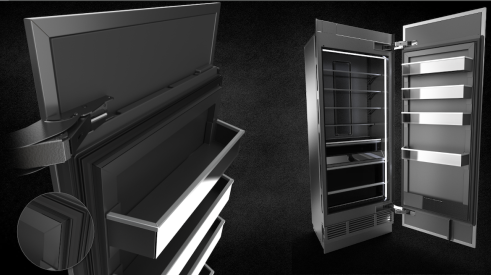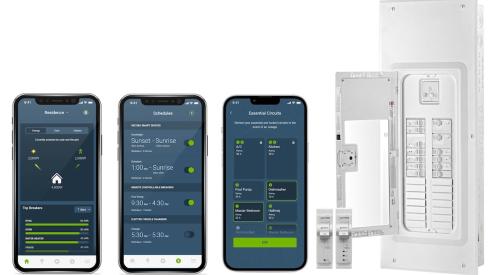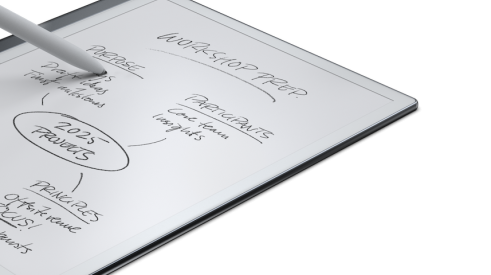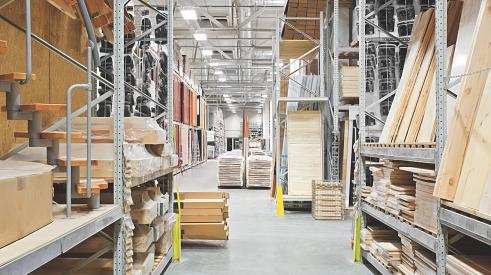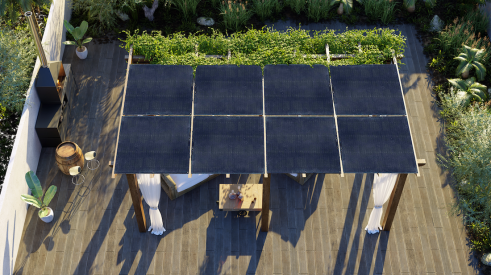A large custom shower provides space for two people. A jetted tub full of hot water gives a stress-relieving water massage. A body shower pulsates with multiple streams of water. A toilet has both a bidet and a self-cleaning wash system. These amenities in today’s bathrooms, designed as private retreats and luxury spaces, may be desirable in the context of our busy, demanding lives. Yet, the bathroom is a place of high water use and many luxury water features may be in conflict with the desire for sustainability in housing.
Toilets, showers, and bathroom faucets are responsible for more than half the water use in a typical home. Precisely because so much water is used in the bathroom, the designer needs to be aware of, and plan for, efficient water use. As populations expand, finite water resources need to be shared with more people. It is a major community—and taxpayer—investment to collect, treat, and deliver high-quality water to residents as well as to treat the resulting wastewater. There are many benefits to efficient and sustainable use of water:
- Reduced pollution caused by excessive water in our wastewater systems.
- Healthier natural wetlands.
- Reduced need for communities to construct water and wastewater treatment facilities.
- Fewer dams and reservoirs needed to provide a water supply.
- Reduced energy to treat both the water supply and wastewater.
Efficient use of water in the bathroom means that water is not wasted but can be used where it is most needed and most appreciated.
Hot water
Much of the water used in a bathroom is heated. Wasting water would also be wasting the energy used to heat the water. Conserving and reducing the energy used to heat water are part of a sustainable home.
Insulating hot water pipes reduces standby heat loss. Putting a secondary water heater in or near the bathroom minimizes the water that is wasted waiting for the hot water to reach the bathroom, as well as the energy lost when the hot water cools in the pipes after hot water is no longer drawn by a bathroom fixture. Installing a tankless or on-demand water heater in the home adds additional savings in energy that is no longer used to maintain a storage tank of hot water.
It is also important to select a water heater that is energy efficient and sized to household needs. A too-large water heater will use extra energy and provide more hot water than is required. There are several technologies and water heater designs that offer particular advantages in energy efficiency. These technologies include high-efficiency gas, tankless (on-demand), heat pump, condensing, and solar.
If a design project will include the need to specify a new water heater, or will include water features that increase the use of hot water, you should encourage your client to consider an energy-efficient water heater. For example, an Energy Star–rated water heater would be a good choice. In addition, some local codes may specify the type or efficiency of a new water heater for remodeling, replacement, or new construction.
Toilets
In most homes, the single greatest use of water is for flushing the toilet. Older toilets may use three, five, or more gallons (liters) per flush. Toilets manufactured since the early 1990s have been federally mandated to use 1.6 gallons (6 liters) of water or less.
Some toilets on the market today use even less water per flush. Toilet manufacturers have improved the technology for toilet flushing systems to make them more efficient, effective, and quieter. An effective flushing system reduces the likelihood that a second flush will be used to remove all the waste. In addition to saving water, efficient and effective flushing systems reduce maintenance.
In a remodeling project, you may be replacing an older toilet that used more water in the flush. Make sure the water pressure is
adequate for the new, more efficient toilet. Explain to your client that the new toilet may sound or operate differently. For example, some toilets have dual flush systems that let the user choose the amount of water per flush. In some communities, the water authority may offer rebates for installing a more water-efficient toilet.
Showers
The early 1990s also saw new regulations limiting showers to 2.5 gallons per minute (gpm) flow rate. Many fixtures offer even more efficient water-flow rates of 2.0 gpm or less. When designing shower systems with multiple showerheads, put individual controls on each fitting. The user can then adjust showerheads to provide only the desired amount of water and reduce waste, especially of hot water. This is particularly important in two-person showers that may be used, at times, by only one person.
Bathtubs
Water use in the bathtub is largely related for the size of the tub. A tub for soaking needs to have enough water to cover most of a person’s body. Sometimes smaller but deeper tubs may use less water. In jetted tubs, the tub must be filled over the jets for operation, so consider the height of the jets. Jets placed lower in the tub can provide an effective massage with less water.
Faucets
Aerators on faucets are important to water conservation. With an aerator, the air added to the water flow increases the pressure and makes the flow seem greater. Water use is reduced. Often water is wasted at the bathroom lavatory faucet during a grooming activity (such as teeth brushing) because it is inconvenient to turn the water on and off. A method to control water use is to install a faucet with an electronic, motion-activator control that only turns on when a hand, toothbrush, or razor is under the faucet. Additionally, foot controls could be used to make it easier to control the faucet to minimize water use.
WaterSense toilets, faucets, showerheads
WaterSense is a public-private partnership program between the EPA and manufacturers to provide water-efficient products. WaterSense products have been independently tested and certified. As a result of meeting the WaterSense standards, the products can bear the WaterSense logo in all packaging, marketing, and promotion.
Generally, products that meet the WaterSense standards are 20 percent more efficient than comparable products on the market. In addition, the products must perform their intended function without sacrificing performance, especially to conserve water. In addition, through an agreement between the EPA and Environment Canada, WaterSense products will be available in Canada.
Choosing WaterSense products for a bathroom offers the designer an excellent opportunity to maximize the sustainable use of water in the bathroom. In fact, the majority of WaterSense products currently available are residential bathroom fixtures. The designer can choose WaterSense toilets, bathroom lavatory faucets and aerators, and showerheads. WaterSense products offer an opportunity to increase water efficiency yet still give the designer many options in creating a unique, and perhaps luxury, space.
The current standard for a toilet is 1.6 gallons per flush (gpf). The WaterSense toilet specification is 1.28 gpf. Some toilets on the market offer even more efficient water use, such as 1.0 gpf.
Manufacturers have achieved the efficient use of water for toilet flushing through the use of different technologies. This includes improving the existing flushing system or using air pressure to power the flush. With a dual flush system, more water is used when flushing solid waste versus liquid waste, but the average water use meets the WaterSense standard. Some toilets may use a pump to assist the flush, requiring an electrical connection for installation.
WaterSense toilets must also meet the minimum MaP threshold for flushing of solid waste: 350 grams of solid waste (including toilet paper) in a single flush. The MaP (Maximum Performance Testing) program creates a standard of effective performance that prevents double flushing, and thus inefficient use of water. MaP is a voluntary testing program recognized in both the United States and Canada.
The average flow rate for a bathroom lavatory faucet today is 2.2 gpm. The WaterSense specification is 1.5 gpm at a water pressure of 60 psi. Aerators and flow-restrictor devices that retrofit a faucet to bring its flow rate to the WaterSense specification also qualify as a WaterSense product.
Showerheads
The average flow rate for a showerhead today is 2.5 gpm. The WaterSense specification is a flow rate of 2.0 gpm, although some showerheads are achieving even lower flow rates, such as 1.75 gpm. Manufacturers are designing water-efficient showerheads to make the water flow feel richer, more luxurious, and more invigorating, yet use less water. A WaterSense showerhead might have a wider spray, pulsing spray, or a massage spray. Your client may want to see the showerhead demonstrated before making a choice, based on personal preference.
Water leaks
An important factor in efficient use of water is to avoid water leaks. Toilets or faucets that drip can waste tremendous amounts of water. For example, the EPA estimates a faucet that loses one drop of water per second can waste 3,000 gallons of water in a year. Talk to your client about selecting quality fixtures, fittings, and water-using appliances that will be easy to maintain and are less likely to develop leaks. This is an important water-conservation measure, but it will also save money and reduce maintenance for the client.
Graywater
So far, the discussion on efficient and sustainable use of water has focused on conserving water use. Another approach is to reuse or recycle water. Reusing water is a sustainable practice that has all of the same benefits of using less water. Recycling water is the term used to describe the practice of treating wastewater, usually in a centralized location, and then using the water for a variety of purposes, including landscaping. Graywater describes the practice of collecting household water from drains and then reusing it onsite for landscaping irrigation or toilet flushing.
The interest in graywater is growing, particularly in the southwestern and western United States where water supplies are limited. Effective use of graywater reduces the demand for treated drinking-quality water and decreases the water going into wastewater treatment facilities.
The model 2012 International Residential Code (IRC) details the design of graywater recycling systems in the section on sanitary drainage. Some local codes now require new residential construction to include connections for graywater plumbing. According to the 2012 IRC, discharge water may be collected from bathtubs, showers, lavatories, clothes washers, and laundry trays for a graywater system. The water collected is then used for flushing toilets and urinals or landscape irrigation.
Including a graywater system in a bathroom design can challenge a designer. The system needs to be correctly sized. There are requirements for additional plumbing pipes. A collection reservoir or storage tank is needed. While the opportunity for implementing an important sustainable practice is exciting, advanced and careful planning is needed. Familiarity with all applicable codes and permits, and perhaps additional expert advice, may be needed.
An innovative design for water recycling and graywater use combines a small hand-washing lavatory directly over the toilet tank. After hand-washing, the water flows into the toilet tank, to be used for the next flush of the toilet. PR
--
The article is excerpted from the NKBA Professional Resource Library volume: Bath Planning, Second Edition by Kathleen Parrott, PhD, CKE, Julia Beamish, PhD, CKD, JoAnn Emmel, PhD, and Mary Jo Peterson, CKD, CBD, CAPS, CAASH. Copyright: 2013 National Kitchen & Bath Association; published by John Wiley & Sons, Inc. This material is reproduced with the permission of John Wiley & Sons, Inc.
Toilets, showers, and bathroom faucets are responsible for more than half the water use in a typical home. Precisely because so much water is used in the bathroom, the designer needs to be aware of, and plan for, efficient water use
Add new comment
Related Stories
Pro's Picks: A Quick Install Composite Stone
This pro completed a high volume facelift project months ahead of schedule
Pella's New Debut Promises Faster, One-Person Window Installs
The window manufacturer promises 3.15x faster installation with its Steady Set system
Marvin Releases Switchable Privacy Glass Window
The privacy glass windows can be purchased from Marvin's Direct Glaze windows
Innovative Products: Window Shades That Create Natural Light
Wait, shouldn't window shades keep light out?
New Insulation Innovation Reshapes Our Thinking of Refrigeration
Whirlpool Corporation's latest innovation allows refrigerators to do more and be more
Innovative Products: A Whole-Home Energy Monitoring System
Homeowners can control their lighting, load control, and EV charging through one app
Pro's Picks: A Paperless Note-Taking Tablet
This remodeler recommends a tablet that makes note-taking and document organization easier
Building Materials Show Stability in 2023
Although supply chain bottlenecks have eased in recent months, shortages of some key materials persist.



